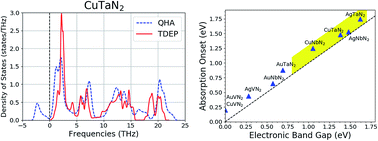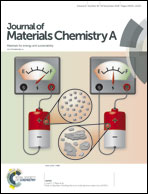Dynamical stabilization in delafossite nitrides for solar energy conversion†
Abstract
Delafossite structured ternary nitrides, ABN2, have been of recent experimental investigation for applications such as tandem solar and photoelectrochemical cells. We present a thorough first principles computational investigation of their stability, electronic structure, and optical properties. Nine compounds, where A = Cu, Ag, Au and B = V, Nb, Ta, were studied. For three of these compounds, CuTaN2, CuNbN2, and AgTaN2, our computations agree well with experimental results. Optimized lattice parameters, formation energies, and mechanical properties have been computed using the generalized gradient approximation (GGA). Phonon density of states computed at zero-temperature shows that all compounds are dynamically unstable at low temperatures. Including finite-temperature anharmonic effects stabilizes all compounds at 300 K, with the exception of AgVN2. Analysis of Crystal Orbital Hamiltonian Populations (COHP) provides insight into the bonding and antibonding characters of A–N and B–N pairs. Instability at low temperatures can be attributed to strong A–N antibonding character near the Fermi energy. B–N bonding is found to be crucial in maintaining stability of the structure. AgVN2 is the only compound to display significant B–N antibonding below the Fermi energy, as well as the strongest degree of A–N antibonding, both of which provide explanation for the sustained instability of this compound up to 900 K. Hybrid functional calculations of electronic and optical properties show that real static dielectric constants in the semiconductors are related to corresponding band gaps through the Moss relation. CuTaN2, CuNbN2, AgTaN2, AgNbN2, AgVN2, AuTaN2, and AuNbN2 exhibit indirect electronic band gaps while CuVN2 and AuVN2 are metallic. Imaginary parts of the dielectric function are characterized by d–d interband transitions in the semiconductors and d–d intraband transitions in the metals. Four compounds, CuTaN2, CuNbN2, AgTaN2, and AgNbN2, are predicted to exhibit large light absorption in the range of 1.0 to 1.7 eV, therefore making these materials good candidates for solar-energy conversion applications. Two compounds, AuTaN2 and AuNbN2, have band gaps and absorption onsets near the ideal range for obtaining high solar-cell conversion efficiency, suggesting that these compounds could become potential candidates as absorber materials in tandem solar cells or for band-gap engineering by alloying.



 Please wait while we load your content...
Please wait while we load your content...
